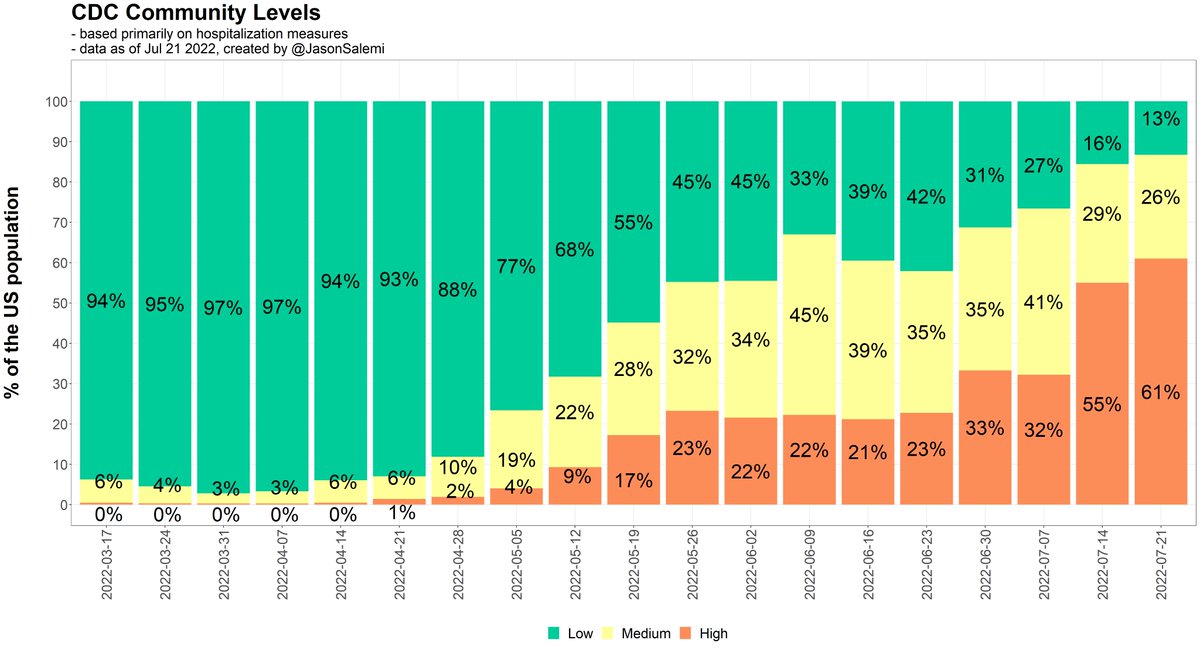
1/ Here's a quick #COVID update - I prepare a weekly report for my college so I thought I should share a broad overview (with #AltText)
VARIANTS: BA.5 continues to have increasing dominance over other variants, representing ~ 9 in 10 new cases
VARIANTS: BA.5 continues to have increasing dominance over other variants, representing ~ 9 in 10 new cases

2/ REPORTED CASES: Though a significant underestimate of actual circulating infections, it is clear that reported cases are down in most areas in the US.
Florida is down 31% relative to two weeks ago (now to ~7,000 cases per day).
Florida is down 31% relative to two weeks ago (now to ~7,000 cases per day).

3/ WASTEWATER DATA: The decrease in reported cases in Florida is supported by Biobot Analytics data in 6 large counties over the past 6 weeks. 

4/ HOSPITAL ADMISSIONS: In Florida, although we still do have among the highest confirmed COVID-19 admission rates in the country, we are seeing a marked decrease in hospitalizations, hospital census, and patients in the ICU.
Below are confirmed adult COVID admissions over time.
Below are confirmed adult COVID admissions over time.

5/ ADULT INPATIENT COVID CENSUS:
LEFT: Similar story in which most (but certainly not all) states are showing a decreasing census in the past week or two.
RIGHT: Florida numbers over the last 8 weeks.

LEFT: Similar story in which most (but certainly not all) states are showing a decreasing census in the past week or two.
RIGHT: Florida numbers over the last 8 weeks.


6/ CDC COMMUNITY LEVELS: These improvements are welcomed because last Thursday's update showed improvement nationally on CDC's hospitalization-based county risk metric, but not in FL.
We will have updated numbers in two days - hoping for a much better picture.
We will have updated numbers in two days - hoping for a much better picture.

7/ CDC TRANSMISSION LEVELS: Again, these will be updated in two days, but transmission levels remain high, not just because of these rates, but because we know they are such an underestimate of infections.
I expect the outlook Thursday (with the update) to be better.
I expect the outlook Thursday (with the update) to be better.

8/ DEATHS
LEFT: In Florida, we have hit a peak (during the current wave) of ~70 deaths per day (hit on July 22). So, it would be wrong to call this wave “mild”.
RIGHT: For context, we’ve had 4 waves in Florida in which average daily deaths exceeded 200 per day (delta was >400).

LEFT: In Florida, we have hit a peak (during the current wave) of ~70 deaths per day (hit on July 22). So, it would be wrong to call this wave “mild”.
RIGHT: For context, we’ve had 4 waves in Florida in which average daily deaths exceeded 200 per day (delta was >400).


9/ VACCINATIONS (for seniors)
Whereas 90% of seniors in Florida have completed a primary series, only 57%got the first booster, and 20%the second booster.
Whereas 90% of seniors in Florida have completed a primary series, only 57%got the first booster, and 20%the second booster.

10/ DASHBOARD
For more details, and interactive visualizations allowing drilldown for all states, please visit 👇
Stay safe!
covid19florida.mystrikingly.com
For more details, and interactive visualizations allowing drilldown for all states, please visit 👇
Stay safe!
covid19florida.mystrikingly.com
• • •
Missing some Tweet in this thread? You can try to
force a refresh



















